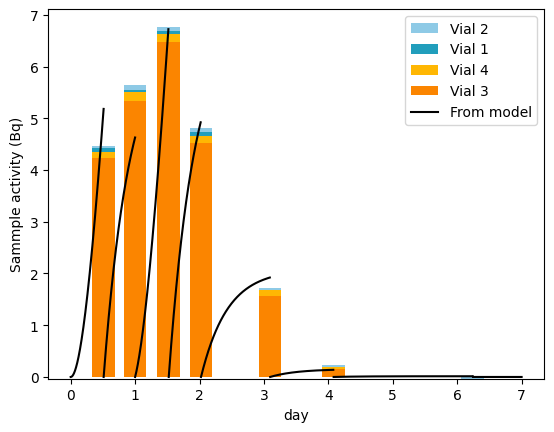How to fit tritium measurements#
Data processing#
Let’s first start with the measurement data. Here we have 7 samples (LIBRASample).
Each LIBRASample has 4 measurements LSCSample (because the bubbler has 4 vials) and a time as a string.
Each LSCSample is defined by an activity and a name/label.
[1]:
from libra_toolbox.tritium import ureg
from libra_toolbox.tritium.lsc_measurements import LSCSample, LIBRASample, GasStream
sample_1 = LIBRASample(
[
LSCSample(0.396 * ureg.Bq, "1-1-1"),
LSCSample(0.375 * ureg.Bq, "1-1-2"),
LSCSample(4.575 * ureg.Bq, "1-1-3"),
LSCSample(0.448 * ureg.Bq, "1-1-4"),
],
time="7/29/2024 09:44 PM",
)
sample_2 = LIBRASample(
[
LSCSample(0.386 * ureg.Bq, "1-2-1"),
LSCSample(0.417 * ureg.Bq, "1-2-2"),
LSCSample(5.659 * ureg.Bq, "1-2-3"),
LSCSample(0.509 * ureg.Bq, "1-2-4"),
],
time="7/30/2024 09:28 AM",
)
sample_3 = LIBRASample(
[
LSCSample(0.393 * ureg.Bq, "1-3-1"),
LSCSample(0.410 * ureg.Bq, "1-3-2"),
LSCSample(6.811 * ureg.Bq, "1-3-3"),
LSCSample(0.492 * ureg.Bq, "1-3-4"),
],
time="7/30/2024 9:59 PM",
)
sample_4 = LIBRASample(
[
LSCSample(0.406 * ureg.Bq, "1-4-1"),
LSCSample(0.403 * ureg.Bq, "1-4-2"),
LSCSample(4.864 * ureg.Bq, "1-4-3"),
LSCSample(0.467 * ureg.Bq, "1-4-4"),
],
time="7/31/2024 9:56 AM",
)
sample_5 = LIBRASample(
[
LSCSample(0.322 * ureg.Bq, "1-5-1"),
LSCSample(0.369 * ureg.Bq, "1-5-2"),
LSCSample(1.900 * ureg.Bq, "1-5-3"),
LSCSample(0.470 * ureg.Bq, "1-5-4"),
],
time="8/1/2024 11:47 AM",
)
sample_6 = LIBRASample(
[
LSCSample(0.343 * ureg.Bq, "1-6-1"),
LSCSample(0.363 * ureg.Bq, "1-6-2"),
LSCSample(0.492 * ureg.Bq, "1-6-3"),
LSCSample(0.361 * ureg.Bq, "1-6-4"),
],
time="8/2/2024 11:24 AM",
)
sample_7 = LIBRASample(
[
LSCSample(0.287 * ureg.Bq, "1-7-1"),
LSCSample(0.367 * ureg.Bq, "1-7-2"),
LSCSample(0.353 * ureg.Bq, "1-7-3"),
LSCSample(0.328 * ureg.Bq, "1-7-4"),
],
time="8/4/2024 3:14 PM",
)
All the LIBRASample objects are then passed to a GasStream class that takes a start_time argument as a string.
[2]:
libra_run = GasStream(
[sample_1, sample_2, sample_3, sample_4, sample_5, sample_6, sample_7],
start_time="7/29/2024 9:28 AM",
)
Note
We have only one gas stream here because it is a 100 mL BABY experiment. For 1L BABY experiments and LIBRA experiments, several GasStream objects will be created.
The background activity (measured with a blank sample) is substracted using the substract_background method of LIBRASample.
Note
We can also use different background LSC samples for different LIBRA samples if need be
[3]:
background_sample = LSCSample(0.334 * ureg.Bq, "background")
for sample in libra_run.samples:
sample.substract_background(background_sample)
We can plot the dataset:
[4]:
from libra_toolbox.tritium.plotting import plot_bars
import matplotlib.pyplot as plt
plot_bars(libra_run)
plt.legend(reverse=True)
plt.show()
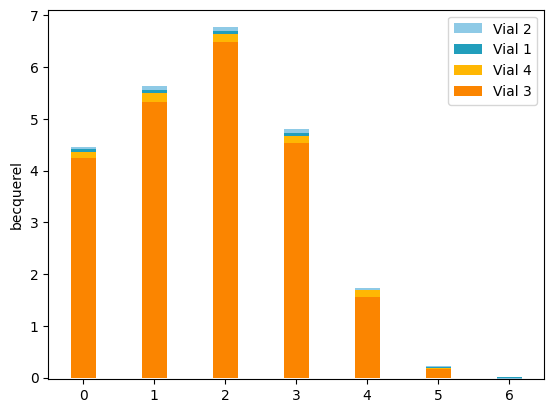
We use get_cumulative_activity to compute the cumulative release from these measurements:
[5]:
release_measurements = libra_run.get_cumulative_activity(form="total")
plt.scatter(libra_run.relative_times_as_pint, release_measurements)
plt.show()
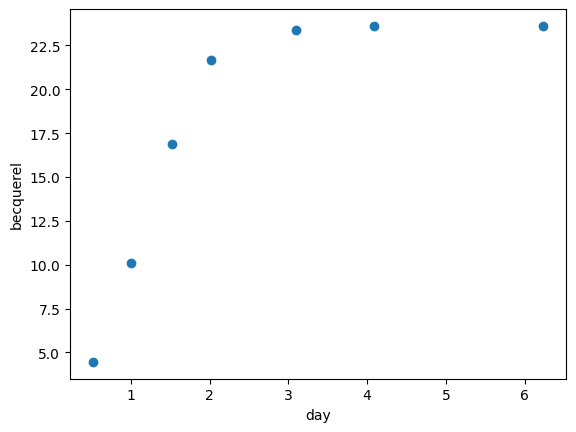
Now that we have processed our data, we can move on to parametric optimisation.
Parametric optimisation#
In order to perform the parametric optimisation, we need to parametrise the model. Here the free parameters are \(k_\mathrm{top}\) and \(k_\mathrm{wall}\).
Note
For details on how to make a tritium release model, see Tritium release
[6]:
from libra_toolbox.tritium.model import Model
import numpy as np
P383_neutron_rate = 4.95e8 / 2 * ureg.neutron * ureg.s**-1
A325_neutron_rate = 2.13e8 / 2 * ureg.neutron * ureg.s**-1
baby_diameter = 1.77 * ureg.inches - 2 * 0.06 * ureg.inches # from CAD drawings
baby_radius = 0.5 * baby_diameter
baby_volume = 100 * ureg.mL
baby_cross_section = np.pi * baby_radius**2
baby_height = baby_volume / baby_cross_section
exposure_time = 12 * ureg.hour
irradiations = [
[0 * ureg.hour, 0 + exposure_time],
[24 * ureg.hour, 24 * ureg.hour + exposure_time],
]
def make_model(k_top, k_wall):
baby_model = Model(
radius=baby_radius,
height=baby_height,
TBR=5.4e-4 * ureg.particle * ureg.neutron**-1,
k_top=k_top,
k_wall=k_wall,
irradiations=irradiations,
neutron_rate=P383_neutron_rate + A325_neutron_rate,
)
return baby_model
We now create an error function that will compute the squared error between the measurements and the values computed by the model:
[7]:
from libra_toolbox.tritium.model import quantity_to_activity
from scipy.interpolate import interp1d
SCALING_FACTOR_K_TOP = 1e-6
SCALING_FACTOR_K_WALL = 1e-8
all_prms = []
errors = []
def error(prms, verbose=False):
global all_prms
global errors
if verbose:
print(f"params = {prms}")
# make the model and run it
model = make_model(
k_top=prms[0] * SCALING_FACTOR_K_TOP * ureg.m * ureg.s**-1,
k_wall=prms[1] * SCALING_FACTOR_K_WALL * ureg.m * ureg.s**-1,
)
model.run(7 * ureg.day)
# compute the error
computed_release = quantity_to_activity(model.integrated_release_top())
computed_release_interp = interp1d(
model.times.to(ureg.day).magnitude, computed_release.to(ureg.Bq).magnitude
)
err = 0
measurements = libra_run.get_cumulative_activity(form="total")
for time, measurement in zip(libra_run.relative_times_as_pint, measurements):
# here we need to use .magnitude because the interpolation function does not accept pint quantities
time = time.to(ureg.day).magnitude
err += (measurement.to(ureg.Bq).magnitude - computed_release_interp(time)) ** 2
err *= ureg.Bq**2
# store the results for later
all_prms.append(prms)
errors.append(err.magnitude)
return err.magnitude
Using the Neldear-Mead algorithm#
We will minimise the error function with scipy.optimize.minimize with an initial guess.
First we use the Nelder-Mead algorithm.
[8]:
from scipy.optimize import minimize
initial_guess = [1.6, 5]
res = minimize(error, initial_guess, method="Nelder-Mead")
/home/remidm/miniconda3/envs/libra-toolbox/lib/python3.12/site-packages/scipy/integrate/_ivp/base.py:23: UnitStrippedWarning: The unit of the quantity is stripped when downcasting to ndarray.
return np.asarray(fun(t, y), dtype=dtype)
Now that the optimiser has found a minimum, let’s plot the results:
[9]:
from libra_toolbox.tritium.plotting import (
plot_integrated_top_release,
plot_integrated_wall_release,
)
optimised_prms = res.x
print(f"Optimised parameters: {optimised_prms}")
model = make_model(
k_top=optimised_prms[0] * SCALING_FACTOR_K_TOP * ureg.m * ureg.s**-1,
k_wall=optimised_prms[1] * SCALING_FACTOR_K_WALL * ureg.m * ureg.s**-1,
)
model.run(7 * ureg.day)
plot_integrated_top_release(model, label="Top release")
plot_integrated_wall_release(model, label="Wall release")
plt.scatter(libra_run.relative_times_as_pint, release_measurements, color="black", label="Measurements")
plt.legend()
plt.show()
Optimised parameters: [1.63987719 4.76387654]
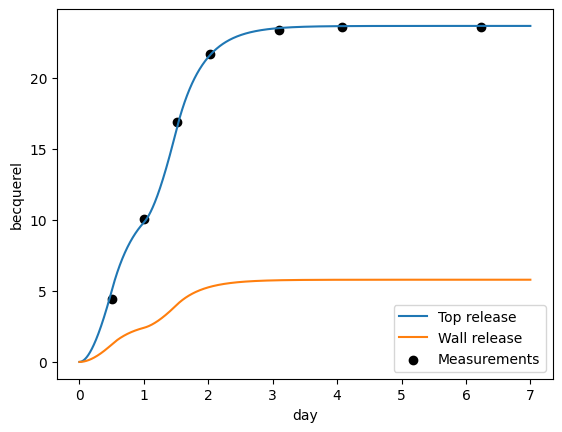
We can also show the parameter space:
[10]:
all_prms_array = np.array(all_prms)
plt.scatter(
all_prms_array[:, 0], all_prms_array[:, 1], c=np.log10(errors), cmap="viridis"
)
plt.plot(all_prms_array[:, 0], all_prms_array[:, 1], color="tab:grey", lw=0.5)
plt.scatter(*optimised_prms, c="tab:red")
plt.annotate(
"Reference",
xy=optimised_prms,
xytext=(optimised_prms[0] - 0.02, optimised_prms[1] + 0.1),
arrowprops=dict(facecolor="black", arrowstyle="-|>"),
)
plt.annotate(
"Initial guess",
xy=initial_guess,
xytext=(initial_guess[0] - 0.004, initial_guess[1] + 0.05),
arrowprops=dict(facecolor="black", arrowstyle="-|>"),
)
plt.xlabel(rf"$k_{{top}}$ (scaled)")
plt.ylabel(rf"$k_{{wall}}$ (scaled)")
plt.show()
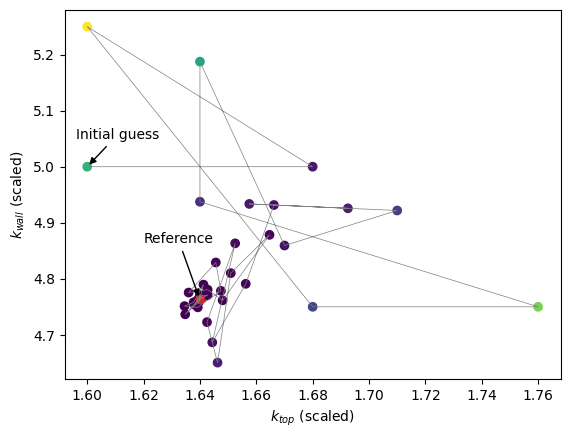
Finally we show how the error decreased with the number of iterations:
[11]:
plt.plot(errors)
plt.xlabel("Iteration")
plt.ylabel("Error (Bq²)")
plt.show()
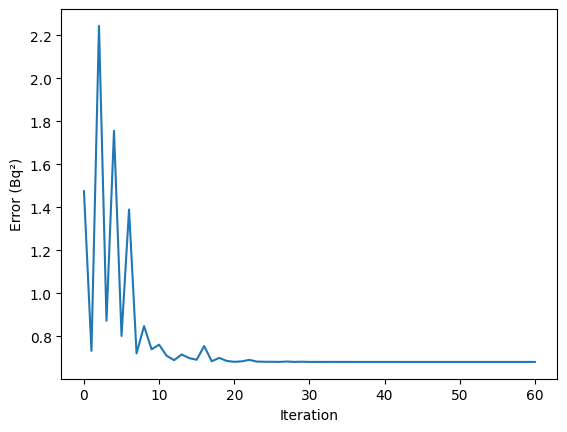
scipy.minimize default algorithm#
What would happen if we chose another algorithm? Let’s use the default algorithm with the same initial guess.
[12]:
from scipy.optimize import minimize
initial_guess = [1.6, 5]
res = minimize(error, initial_guess)
/home/remidm/miniconda3/envs/libra-toolbox/lib/python3.12/site-packages/scipy/integrate/_ivp/base.py:23: UnitStrippedWarning: The unit of the quantity is stripped when downcasting to ndarray.
return np.asarray(fun(t, y), dtype=dtype)
[13]:
all_prms_array = np.array(all_prms)
plt.scatter(
all_prms_array[:, 0], all_prms_array[:, 1], c=np.log10(errors), cmap="viridis"
)
plt.plot(all_prms_array[:, 0], all_prms_array[:, 1], color="tab:grey", lw=0.5)
plt.scatter(*optimised_prms, c="tab:red")
plt.annotate(
"Initial guess",
xy=initial_guess,
xytext=(initial_guess[0] - 0.004, initial_guess[1] + 0.05),
arrowprops=dict(facecolor="black", arrowstyle="-|>"),
)
plt.xlabel(rf"$k_{{top}}$ (scaled)")
plt.ylabel(rf"$k_{{wall}}$ (scaled)")
plt.show()
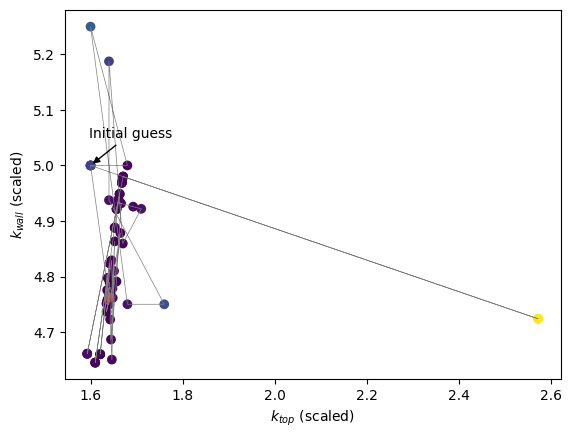
The algorithm converged towards the same minimum.
[14]:
plt.plot(errors)
plt.xlabel("Iteration")
plt.ylabel("Error (Bq²)")
plt.show()
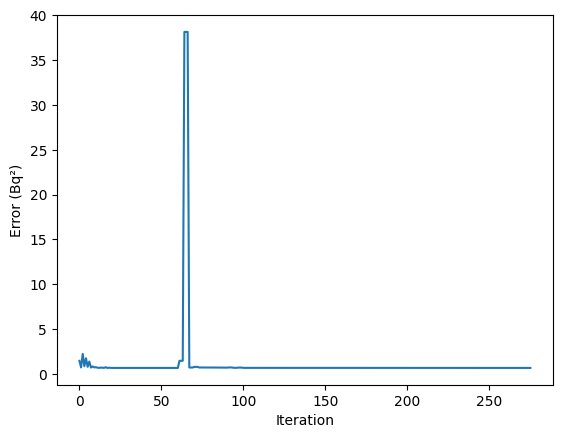
However, it required a lot more iterations (or rather function calls), which is why it took longer to converge.
This is because this algorithm is not derivative free. Nelder-Mead is therefore preferred.
Comparing sample activity to predictions#
It is also possible to compare the measured sample activity to the sample activity predicted by the model (see LSC sample activity)
[15]:
from libra_toolbox.tritium.plotting import plot_sample_activity_top
plot_sample_activity_top(
model, replacement_times=libra_run.relative_times_as_pint, color="black", label="From model"
)
plot_bars(libra_run, index=libra_run.relative_times_as_pint)
plt.legend(reverse=True)
plt.ylabel("Sammple activity (Bq)")
plt.show()
